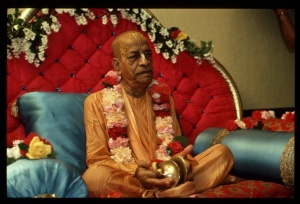SB 3.29.35

A.C. Bhaktivedanta Swami Prabhupada
TEXT 35
- bhakti-yogaś ca yogaś ca
- mayā mānavy udīritaḥ
- yayor ekatareṇaiva
- puruṣaḥ puruṣaṁ vrajet
SYNONYMS
bhakti-yogaḥ—devotional service; ca—and; yogaḥ—mystic yoga; ca—also; mayā—by Me; mānavi—O daughter of Manu; udīritaḥ—described; yayoḥ—of which two; ekatareṇa—by either one; eva—alone; puruṣaḥ—a person; puruṣam—the Supreme Person; vrajet—can achieve.
TRANSLATION
My dear mother, O daughter of Manu, a devotee who applies the science of devotional service and mystic yoga in this way can achieve the abode of the Supreme Person simply by that devotional service.
PURPORT
Herein the Supreme Personality of Godhead Kapiladeva perfectly explains that the mystic yoga system, consisting of eight different kinds of yoga activities, has to be performed with the aim of coming to the perfectional stage of bhakti-yoga. It is not acceptable for one to be satisfied simply by practicing the sitting postures and thinking himself complete. By meditation one must attain the stage of devotional service. As previously described, a yogī is advised to meditate on the form of Lord Viṣṇu from point to point, from the ankles to the legs to the knees to the thighs to the chest to the neck, and in this way gradually up to the face and then to the ornaments. There is no question of impersonal meditation.
When, by meditation on the Supreme Personality of Godhead in all detail, one comes to the point of love of God, that is the point of bhakti-yoga, and at that point he must actually render service to the Lord out of transcendental love. Anyone who practices yoga and comes to the point of devotional service can attain the Supreme Personality of Godhead in His transcendental abode. Here it is clearly stated, puruṣaḥ puruṣaṁ vrajet: the puruṣa, the living entity, goes to the Supreme Person. The Supreme Personality of Godhead and the living entity are qualitatively one; both are defined as puruṣa. The quality of puruṣa exists both in the Supreme Godhead and in the living entity. Puruṣa means "enjoyer," and the spirit of enjoyment is present both in the living entity and in the Supreme Lord. The difference is that the quantity of enjoyment is not equal. The living entity cannot experience the same quantity of enjoyment as the Supreme Personality of Godhead. An analogy may be made with a rich man and a poor man: the propensity for enjoyment is present in both, but the poor man cannot enjoy in the same quantity as the rich man. When the poor man dovetails his desires with those of the rich man, however, and when there is cooperation between the poor man and the rich man, or between the big and the small man, then the enjoyment is shared equally. That is like bhakti-yoga. puruṣaḥ puruṣaṁ vrajet: when the living entity enters into the kingdom of God and cooperates with the Supreme Lord by giving Him enjoyment, he enjoys the same facility or the same amount of pleasure as the Supreme Personality of Godhead.
On the other hand, when the living entity wants to enjoy by imitating the Supreme Personality of Godhead, his desire is called māyā, and it puts him in the material atmosphere. A living entity who wants to enjoy on his personal account and not cooperate with the Supreme Lord is engaged in materialistic life. As soon as he dovetails his enjoyment with the Supreme Personality of Godhead, he is engaged in spiritual life. An example may be cited here: The different limbs of the body cannot enjoy life independently; they must cooperate with the whole body and supply food to the stomach. In so doing, all the different parts of the body enjoy equally in cooperation with the whole body. That is the philosophy of acintya-bhedābheda, simultaneous oneness and difference. The living entity cannot enjoy life in opposition to the Supreme Lord; he has to dovetail his activities with the Lord by practicing bhakti-yoga.
It is said herein that one can approach the Supreme Personality of Godhead by either the yoga process or the bhakti-yoga process. This indicates that factually there is no difference between yoga and bhakti-yoga because the target of both is Viṣṇu. In the modern age, however, a yoga process has been manufactured which aims at something void and impersonal. Actually, yoga means meditation on the form of Lord Viṣṇu. If the yoga practice is actually performed according to the standard direction, there is no difference between yoga and bhakti-yoga.